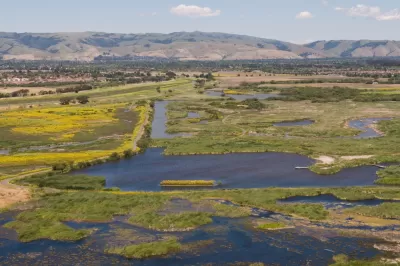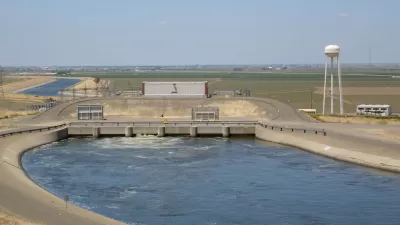From clean drinking supply to sinking infrastructure, California has a lot to worry about when it comes to water. Two upcoming bonds could make a dent in the work ahead.

California voters will soon decide whether to fund two water bonds for a total of $13 billion. The Planning Report examines the complementary proposals—one in June and one in November—in an interview with Jerry Meral, a veteran of natural resource management and a proponent of the November bond.
Up first on the June ballot, Proposition 68 would spread $4 billion among parks, trails, and land conservation, as well as water recycling. More money specifically for water infrastructure would come from the $8.9 billion Water Supply and Water Quality bond scheduled for the November ballot. That measure is expansive, covering 100 different types of water projects, Meral says.. Some of its major funding categories include:
- Safe drinking water and wastewater disposal ("a big priority in disadvantaged communities," Meral notes.)
- Wastewater recycling, water conservation, and watershed restoration.
- Implementation of California's Sustainable Groundwater Management Act—a landmark bill meant to help the state replenish the copious amounts of water it draws from underground every year.
- Repair of the Oroville Dam, whose failure in 2017 forced the evacuation of 188,000 people, and of the sinking Friant-Kern Canal, which supplies key farmland areas.
- Restoring the polluted, shrinking Salton Sea. "I daresay the Salton Sea is the single greatest threat to air quality in the United States," Meral says, as the exposed seabed could "blow dust of biblical proportions" all over the state. The two bonds together cover the funding needed for the state's restoration plan.
Meral also talks about California's reliance on bond measures to fund major infrastructure investments, and the willingness of voters to pay for them all. It's not an ideal long-term strategy, he stresses, but for the moment, it could bode well for water in the state—especially since the need for funding is "substantially greater" than the upcoming bond measures combined.
FULL STORY: November Water Bond Promises $8.9 Billion Towards Securing California’s Future

Study: Maui’s Plan to Convert Vacation Rentals to Long-Term Housing Could Cause Nearly $1 Billion Economic Loss
The plan would reduce visitor accommodation by 25,% resulting in 1,900 jobs lost.

Alabama: Trump Terminates Settlements for Black Communities Harmed By Raw Sewage
Trump deemed the landmark civil rights agreement “illegal DEI and environmental justice policy.”

Why Should We Subsidize Public Transportation?
Many public transit agencies face financial stress due to rising costs, declining fare revenue, and declining subsidies. Transit advocates must provide a strong business case for increasing public transit funding.

Paris Bike Boom Leads to Steep Drop in Air Pollution
The French city’s air quality has improved dramatically in the past 20 years, coinciding with a growth in cycling.

Why Housing Costs More to Build in California Than in Texas
Hard costs like labor and materials combined with ‘soft’ costs such as permitting make building in the San Francisco Bay Area almost three times as costly as in Texas cities.

San Diego County Sees a Rise in Urban Coyotes
San Diego County experiences a rise in urban coyotes, as sightings become prevalent throughout its urban neighbourhoods and surrounding areas.
Urban Design for Planners 1: Software Tools
This six-course series explores essential urban design concepts using open source software and equips planners with the tools they need to participate fully in the urban design process.
Planning for Universal Design
Learn the tools for implementing Universal Design in planning regulations.
Smith Gee Studio
Alamo Area Metropolitan Planning Organization
City of Santa Clarita
Institute for Housing and Urban Development Studies (IHS)
City of Grandview
Harvard GSD Executive Education
Toledo-Lucas County Plan Commissions
Salt Lake City
NYU Wagner Graduate School of Public Service




























